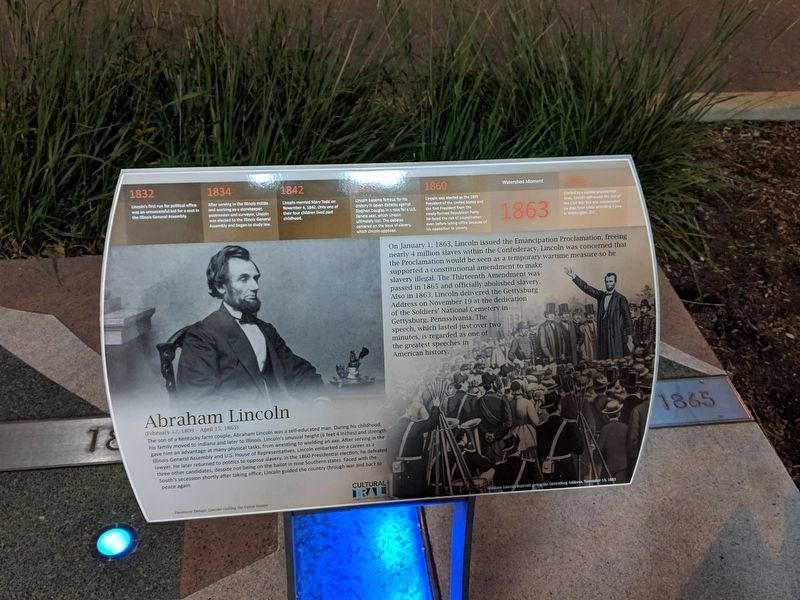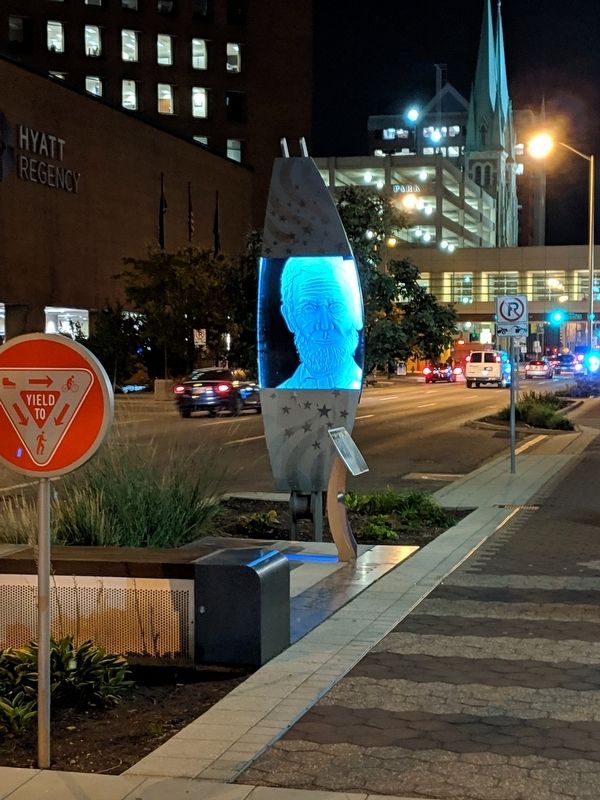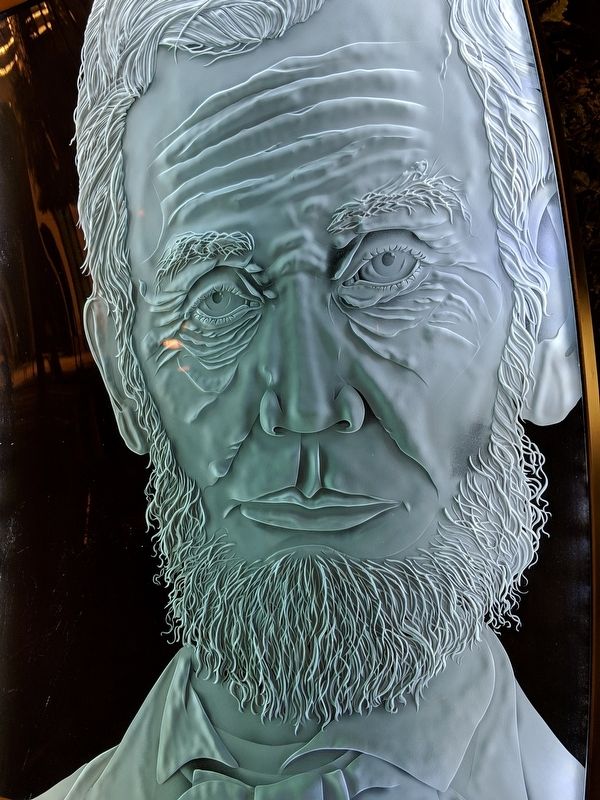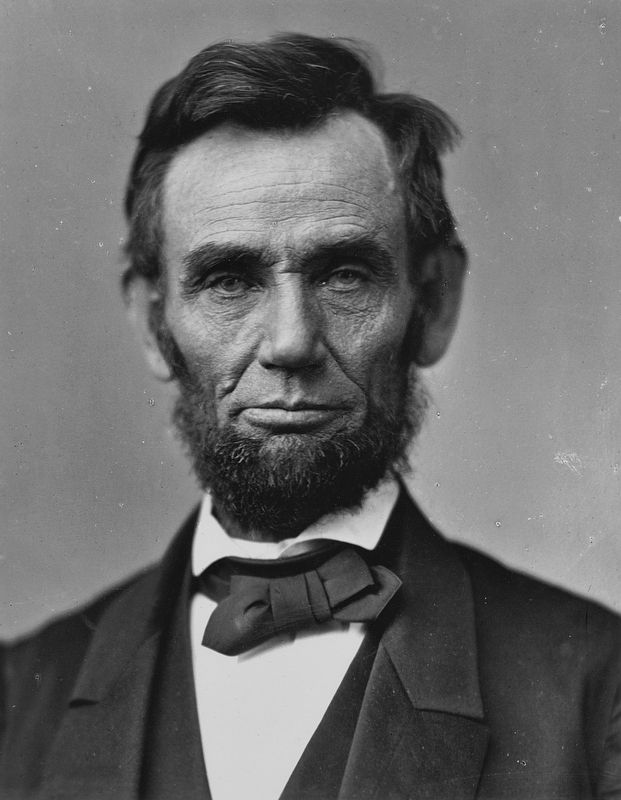Mile Square in Indianapolis in Marion County, Indiana — The American Midwest (Great Lakes)
Abraham Lincoln
(February 12, 1809 - April 15, 1865)
The son of a Kentucky farm couple, Abraham Lincoln was a self-educated man. During his childhood, his family moved to Indiana and later to Illinois. Lincoln's unusual height (6 feet 4 inches) and strength gave him an advantage at many physical tasks, from wrestling to wielding an axe. After serving in the Illinois General Assembly and U.S. House of Representatives, Lincoln embarked on a career as a lawyer. He later returned to politics to oppose slavery. In the 1860 Presidential election, he defeated three other candidates, despite not being on the ballot in nine Southern states. Faced with the South's secession shortly after taking office, Lincoln guided the country through war and back to peace again.
1832
Lincoln's first run for political office was an unsuccessful bid for a seat in the Illinois General Assembly.
1834
After serving in the Illinois militia and working as a storekeeper, postmaster and surveyor, Lincoln was elected to the Illinois General Assembly and began to study law.
1842
Lincoln married Mary Todd on November 4, 1842. Only one of their four children lived past childhood.
1858
Lincoln became famous for his oratory in seven debates against Stephen Douglas in a race for a U.S. Senate seat, which Lincoln ultimately lost. The debates centered on the Issue of slavery, which Lincoln opposed.
1860
Lincoln was elected as the 16th President of the United States and the first President from the newly-formed Republican Party. He faced the risk of assassination even before taking office because of his opposition to slavery.
Watershed Moment
1863
On January 1, 1863, Lincoln issued the Emancipation Proclamation, freeing nearly 4 million slaves within the Confederacy. Lincoln was concerned that the Proclamation would be seen as a temporary wartime measure so he supported a constitutional amendment to make slavery illegal. The Thirteenth Amendment was passed in 1865 and officially abolished slavery. Also in 1863, Lincoln delivered the Gettysburg Address on November 19 at the dedication of the Soldiers' National Cemetery in Gettysburg, Pennsylvania. The speech, which lasted just over two minutes, is regarded as one of the greatest speeches in American history.
1865
Elected to a second presidential term, Lincoln witnessed the end of the Civil War but was assassinated six days later while attending a play in Washington, D.C.
Erected by Indianapolis Cultural Trail.
Topics and series. This historical marker is listed in this topic list: Government & Politics. In addition, it is included in the Former U.S. Presidents: #16 Abraham Lincoln, and the Indiana, Cultural Trail Indianapolis series lists. A significant historical date for this entry is January 1, 1863.
Location. 39° 46.02′ N, 86° 9.708′ W. Marker is in Indianapolis, Indiana, in Marion County. It is in Mile Square. Marker can be reached from the intersection of South Capitol Avenue and West Washington Street, on the right when traveling south. Touch for map. Marker is in this post office area: Indianapolis IN 46204, United States of America. Touch for directions.
Other nearby markers. At least 8 other markers are within walking distance of this marker. Indiana Woman's Suffrage (within shouting distance of this marker); Harriette Bailey Conn (within shouting distance of this marker); Indiana Theatre (within shouting distance of this marker); Thomas Andrews Hendricks (within shouting distance of this marker); Thomas A. Hendricks, 1890 (within shouting distance of this marker); Indiana State House (within shouting distance of this marker); The National Road / Indiana Centennial (within shouting distance of this marker); Native White Oak Tree (about 300 feet away, measured in a direct line). Touch for a list and map of all markers in Indianapolis.
Also see . . .
1. Abraham Lincoln at Biography.com. (Submitted on December 17, 2020, by Mike Wintermantel of Pittsburgh, Pennsylvania.)
2. Abraham Lincoln at FindAGrave.com. (Submitted on December 17, 2020, by Mike Wintermantel of Pittsburgh, Pennsylvania.)
Credits. This page was last revised on February 4, 2023. It was originally submitted on December 17, 2020, by Mike Wintermantel of Pittsburgh, Pennsylvania. This page has been viewed 282 times since then and 21 times this year. Last updated on December 2, 2021, by Carl Gordon Moore Jr. of North East, Maryland. Photos: 1, 2, 3, 4. submitted on December 17, 2020, by Mike Wintermantel of Pittsburgh, Pennsylvania. • Devry Becker Jones was the editor who published this page.



